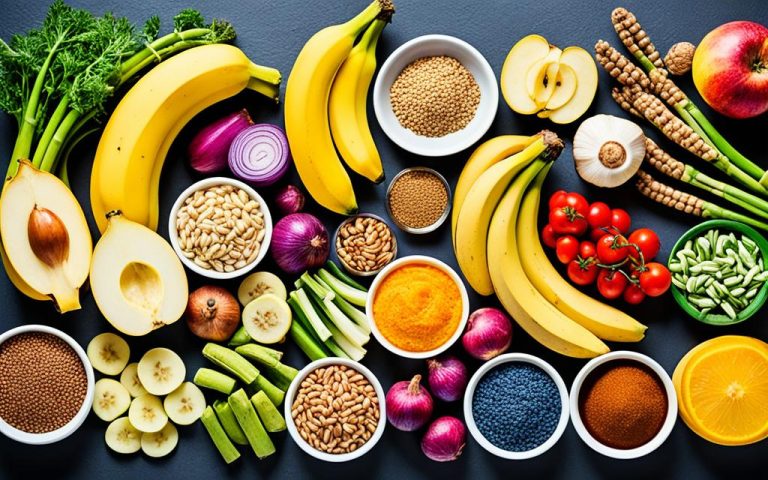Insulin Resistance: Early Signs and Treatment
Reflect on your body’s current condition; have you noticed any troubling symptoms lately? Perhaps you’ve found yourself struggling with persistent belly fat or an unrelenting desire for sweets. These could be construed as mere nuisances, yet they may indicate the early signs of insulin resistance—a precursor to numerous health complications. Recognising such signs is pivotal in managing insulin resistance effectively, preemptively addressing a condition that could spiral into more severe ailments.
Insulin resistance treatment is multi-faceted, encompassing both lifestyle alterations and, where necessary, medical interventions. Both strategies are instrumental in restoring your body’s insulin sensitivity and mitigating the associated risks. As you read on, remember that the overture of experiences like fatigue or hunger pangs could potentially be your body signalling for help. Your awareness and response to these clues are crucial in managing insulin resistance and safeguarding your well-being.
Key Takeaways
- Be vigilant of telltale signs such as persistent abdominal fat and sugar cravings, which can signify developing insulin resistance.
- Insulin resistance could be the harbinger of future health issues; timely detection is your ally in prevention.
- Comprehensive management of insulin resistance often requires you to embrace healthy dietary and exercise routines.
- Medical treatments, when recommended, can offer additional support in regaining insulin sensitivity.
- The key to successful management lies in understanding the subtleties of your body’s signals and responding accordingly.
Understanding Insulin Resistance and Its Impact on Your Health
Insulin resistance is a physiological condition that has far-reaching health implications for individuals. Essentially, it refers to the body’s reduced ability to respond to the action of the hormone insulin. This hormone plays a crucial role in glucose metabolism, acting as a key that allows glucose to enter the cells from the bloodstream. Normally, insulin helps to maintain energy balance and supports cellular functions. However, when your insulin sensitivity decreases, glucose begins to accumulate in the bloodstream, setting the stage for a host of health challenges, including the potential development of type 2 diabetes and cardiovascular diseases.
At the core of the insulin resistance impact is the disruption of metabolic activities. This disruption affects not just the glucose levels but also the metabolism of fats and proteins, leading to complex dysfunctions within your body. The relationship between insulin resistance and one’s health is multifaceted, influencing everything from energy production to hormone balance.
As you navigate through the nuances of insulin resistance, it is important to understand that this condition doesn’t develop overnight but gradually over time. Recognizing the signs early on can be instrumental in mitigating adverse effects on your health.
| Aspect of Health | Effect of High Insulin Resistance | Effect of Improved Insulin Sensitivity |
|---|---|---|
| Blood Sugar Levels | Elevated, leading to potential hyperglycaemia | Stabilised, reducing the risk of diabetes |
| Energy Distribution | Inefficient, causing fatigue and energy spikes | Optimised, promoting consistent energy throughout the day |
| Cardiovascular Health | Strained, increasing the risk of heart-related diseases | Improved, due to better lipid profiles and blood pressure levels |
| Weight Management | Complicated, often experiencing weight gain and obesity | Easier, as the body uses glucose effectively |
Implementing lifestyle changes such as adhering to a balanced diet and incorporating regular physical exercise can significantly enhance insulin sensitivity and halt the progression of insulin resistance. These adjustments might seem straightforward, but they have profound effects on resetting your body’s ability to manage glucose and protect against the escalating cycle of metabolic disturbances.
Recognising the First Indicators of Insulin Resistance
Gleaning insight into the first indicators of insulin resistance is imperative for taking timely action and managing your health effectively. Awareness of the classic insulin resistance symptoms can empower you to seek further medical advice and potentially avert the advancement of more serious conditions linked to insulin resistance.
Unexplained Fatigue
One of the early warnings that your body may not be handling insulin correctly is the onset of unexplained fatigue. This isn’t the ordinary tiredness that follows a busy day or a poor night’s sleep. Rather, it’s a chronic state of exhaustion that persists despite rest. It occurs because your cells struggle to absorb glucose efficiently, depriving them of their primary energy source.
Increased Hunger
Regularly feeling famished, specifically with cravings for carbohydrate-rich foods, can be due to your cells not receiving sufficient energy from glucose. As a result, your body persistently signals for more food in an attempt to get the energy it requires, which is a fundamental symptom of insulin resistance.
Difficulty Losing Weight
If you’re finding weight loss to be an uphill battle regardless of following a nutritious diet and partaking in regular exercise, it may be an early sign of insulin resistance. Insulin plays a pivotal role in the way our bodies store fat, and when insulin function is compromised, losing weight becomes increasingly challenging.
It’s prudent to be vigilant for these symptoms, and if you observe any, consult with a healthcare provider to discuss recognising insulin resistance thoroughly. While these symptoms can be subtle and easily overlooked, early identification and intervention can have a substantive impact on your health trajectory.
| Indicator | Possible Reasons | Why It’s a Concern |
|---|---|---|
| Unexplained Fatigue | Inefficient glucose uptake by cells leading to energy deficit | Constant tiredness affecting daily life and productivity |
| Increased Hunger | Cells signalling for more energy due to lack of glucose absorption | May lead to overeating and weight gain |
| Difficulty Losing Weight | Altered fat storage due to impaired insulin function | Weight that’s resistant to dieting and exercise can elevate health risks |
These symptoms can often go unnoticed, hence understanding and recognising insulin resistance is a crucial step towards maintaining optimal health. By keeping an eye on these insulin resistance symptoms and the first indicators of insulin resistance, you can take appropriate actions to manage your well-being effectively.
Insulin Resistance – Recognition and Management
The journey to managing insulin resistance begins with an accurate insulin resistance diagnosis, a crucial step in preventing the progression of this condition. Healthcare professionals rely on a series of diagnostic tools to detect insulin resistance, ensuring that tailored management strategies can be implemented effectively.
Once insulin resistance is identified, a comprehensive approach to managing insulin resistance is vital. From dietary adjustments to physical activity enhancements, managing insulin resistance encompasses both pharmacological treatments and significant lifestyle changes to mediate blood glucose levels and improve your body’s insulin sensitivity.
- Regular monitoring of blood glucose to track the effectiveness of treatment plans.
- Lifestyle interventions including a balanced diet and consistent exercise.
- Medications that specifically target insulin sensitivity and secretion.
The knowledge and commitment to managing insulin resistance significantly impact one’s wellbeing, illustrating the power these measures have in altering the course of the condition and ensuring a healthier future.
The Connection Between Insulin Sensitivity and Metabolic Syndrome
Exploring the nexus between insulin sensitivity and metabolic syndrome is crucial for understanding one of the significant insulin resistance risk factors. As you delve into this topic, you’ll uncover how a decrease in sensitivity to insulin is intrinsically linked to a cluster of conditions that elevate the risk of heart disease, stroke, and diabetes.
Defining Metabolic Syndrome
Metabolic syndrome constitutes a conglomerate of symptoms and physiological markers that, when present together, can drastically increase your chances of cardiovascular complications. This syndrome is clinically identified when at least three of the following five conditions are met: elevated fasting glucose, high blood pressure, excess abdominal fat, high triglycerides, and reduced high-density lipoprotein (HDL) cholesterol levels.
How Insulin Sensitivity Influences Metabolism
Your metabolic health is profoundly influenced by insulin sensitivity. When your cells are sensitive to the action of insulin, glucose can be efficiently taken up from the bloodstream and used for energy. Conversely, when cells become resistant, the excess glucose can lead to type 2 diabetes and other components of metabolic syndrome.
To effectively combat the risk of developing metabolic syndrome, strategies targeted at bolstering insulin sensitivity are paramount. These include weight management, increased physical activity, and dietary adjustments focusing on whole, unprocessed foods.
| Criteria for Metabolic Syndrome | Risk Factor | Impact of Improved Insulin Sensitivity |
|---|---|---|
| Elevated fasting glucose | Insulin Resistance | Lower blood sugar levels |
| High blood pressure | Endothelial Dysfunction | Improved vascular health |
| Excess abdominal fat | Inflammation | Reduced adiposity |
| High triglycerides | Hyperlipidemia | Improved lipid profile |
| Low HDL cholesterol | Cardiovascular Disease Risk | Increased HDL levels |
Understanding and improving insulin sensitivity is integral to your metabolic well-being. By recognising the link between insulin function and metabolic syndrome, you can take informed steps towards preserving your health.
Exploring the Role of Glucose Metabolism in Insulin Resistance
At the heart of your body’s energy utilisation lies the intricate process of glucose metabolism, a vital function for maintaining homeostatic balance and fuelling bodily activities. When this process works efficiently, cells are readily supplied with glucose for energy through the actions of insulin. However, disruptions in this mechanism, often due to insulin resistance, can lead to a perilous cascade of health concerns, with hyperglycaemia being a primary symptom.
Insulin resistance hampers glucose uptake in your cells, compelling the pancreas to produce excessive amounts of insulin, which over time, can exacerbate the cells’ unresponsiveness to insulin. Consequently, this presents a significant risk for developing insulin resistance complications, as chronic hyperglycaemia poses a severe strain on your body’s regulatory systems. The liver’s normal metabolic processes are also altered, leading to increased glucose production further aggravating the circumstances.
| Normal Glucose Metabolism | Glucose Metabolism in Insulin Resistance |
|---|---|
| Insulin effectively promotes glucose uptake | Cells become less responsive to insulin |
| Glucose is used or stored appropriately | Excess glucose leads to hyperglycaemia |
| Balanced glucose production in the liver | The liver overproduces glucose |
| Maintains energy levels throughout the day | Energy fluctuations and increased fatigue |
Understanding the significant shifts that occur within your body’s metabolism due to insulin resistance can illuminate why measures to preserve glucose metabolism are essential. Strategies involving dietary adjustments, adequate physical activity, and medications where necessary, form the cornerstone of mitigating the escalation of such complications. By focusing on the overarching importance of glucose metabolism, you become equipped to combat insulin resistance complications more effectively, thereby maintaining optimal health.
Key Strategies for Insulin Resistance Diagnosis
When confronting the challenge of insulin resistance, precise diagnosis is essential for effective management. Familiarising yourself with various diagnostic methods can empower you to better understand your health. In this section, we concentrate on the crucial blood examinations that medical professionals utilise to diagnose insulin resistance and monitor its progression over time.
Blood Tests and What They Reveal
Medical practitioners rely on a series of blood tests to ascertain your level of insulin resistance. These tests provide valuable insights into your body’s glucose handling and insulin function. Two commonly prescribed blood tests for insulin resistance include the fasting insulin test and the HOMA-IR (Homeostatic Model Assessment of Insulin Resistance), which evaluates insulin resistance using your fasting blood sugar and insulin levels.
These blood tests can disclose patterns indicative of insulin resistance, such as higher-than-average insulin levels when paired with normal glucose levels, suggesting that your body is producing more insulin than usual to maintain glucose balance.
Understanding A1C and Glucose Tolerance Tests
The A1C test, or glycated haemoglobin test, offers a snapshot of your average blood sugar levels over the past 2-3 months. It measures the percentage of haemoglobin coated with sugar, with higher percentages indicating a greater risk of insulin resistance and potential progression towards diabetes.
Equally important is the glucose tolerance test, which gauges your body’s response to sugar. After an initial blood sample is taken, you’ll consume a high-glucose beverage, followed by subsequent blood samples at one, two, and sometimes three hours later. A consistent rise in blood sugar levels across these samples can signal insulin resistance.
Ensuring an accurate diagnosis is pivotal for adopting the right treatment pathway early on. Whether through lifestyle modifications or medication, addressing insulin resistance at its onset can significantly diminish the risk of diabetic complications, making early and accurate diagnosis paramount.

Comprehensive Treatment Approaches for Insulin Resistance
Addressing insulin resistance requires a multifaceted approach that includes both medical interventions and significant lifestyle modifications. With an understanding of the various treatments available, you can work towards managing insulin resistance effectively.
Medications and Their Role
The use of medications for insulin resistance is a key component of treatment. These drugs aim to improve the body’s responsiveness to insulin or to decrease glucose production in the liver. Metformin, for instance, is a widely prescribed drug that enhances insulin sensitivity and is often the first line of therapy for Type 2 diabetes.
Lifestyle Interventions: Diet and Physical Activity
Complementing medication with lifestyle interventions is crucial. Adopting a diet that promotes insulin sensitivity and engaging in regular physical activity can lead to significant health improvements and even reduce the need for medication.
A balanced diet, rich in fibre and lean protein, and low in processed sugars and saturated fats, supports the management of insulin resistance. Furthermore, activities such as aerobic exercise, resistance training, and flexibility workouts can enhance insulin utilisation in the body.
| Lifestyle Intervention | Benefits |
|---|---|
| Healthy Eating Habits | Improves insulin sensitivity, lowers blood sugar levels |
| Regular Physical Activity | Increases muscle insulin uptake, reduces abdominal fat |
| Weight Management | Decreases insulin resistance, minimises risk of diabetes |
By combining effective insulin resistance treatment options with proactive lifestyle choices, you can take control of your health and lay the foundation for a more resilient and robust metabolic profile.
Addressing Insulin Resistance Risk Factors
Understanding the insulin resistance risk factors is crucial in taking preemptive steps towards preventing insulin resistance. The primary contributors to this condition often include a genetic predisposition, embodying excess weight, particularly around the abdomen, and a sedentary lifestyle, which can detrimentally affect your body’s insulin sensitivity.
Lifestyle changes play a pivotal role, not just in mitigating these risks but also in improving overall health. Below, you’ll find a table outlining actionable strategies that can significantly lower the chances of developing insulin resistance:
| Risk Factor | Lifestyle Change | Expected Benefit |
|---|---|---|
| Genetic Predisposition | Regular health screenings | Early detection and intervention |
| Obesity | Adopting a balanced diet | Weight management and reduced fat storage |
| Sedentary Lifestyle | Integrating physical activity into daily routine | Improved insulin sensitivity and energy levels |
By acknowledging these risk factors, you are better equipped to make lifestyle changes that directly contribute to preventing insulin resistance. Incorporating balanced nutritional choices and regular exercise into your daily life can not only thwart the progression of insulin resistance but also fortify your body against future health complications. It’s never too late to adjust your habits and enhance your quality of life.
Common Complications Associated with Insulin Resistance
Insulin resistance isn’t merely a singular health condition; it can act as a launching pad for numerous other health issues that manifest as a cascading series of complications. Understanding the short-term effects and identifying long-term risks are crucial steps for mitigating the profound impact insulin resistance can have on your overall well-being.
Short-term Consequences
The immediate effects of insulin resistance might sometimes be subtle, making them easy to overlook. Yet, these short-term effects can progressively interfere with your daily life. They surface as fluctuating energy levels, often marked by a combination of lethargy and spikes in blood sugar that can leave you feeling uncharacteristically fatigued, despite adequate rest.
- Unexpected drops in blood glucose leading to hypoglycemia
- Increased need for snacking due to poor satiety
- Feelings of brain fog and decreased cognitive function
Long-term Health Risks
As time marches on, the complications of insulin resistance often escalate into more severe conditions. Being cognisant of these long-term risks is a vital part of your health literacy. These risks are not merely inconvenient; they can be life-altering or even life-threatening if left unmanaged.
| Long-term Complication | Description | Risk Mitigation Strategies |
|---|---|---|
| Type 2 Diabetes | When your body cannot effectively use insulin, a persistent high blood sugar ensues, paving the way for Type 2 diabetes. | Regular monitoring of blood glucose levels, dietary regulation, and maintenance of a healthy weight. |
| Cardiovascular Disease | Insulin resistance can lead to high cholesterol levels and high blood pressure, both of which increase the risk of heart disease and stroke. | Managing blood pressure and cholesterol through lifestyle and, if necessary, medication. |
| Polycystic Ovary Syndrome (PCOS) | Often associated with insulin resistance, PCOS can result in infertility and metabolic issues in women. | Lifestyle interventions including diet, exercise, and potentially, insulin-sensitising drugs. |
It is apparent that the challenges posed by insulin resistance extend beyond immediate concerns, potentially casting a long shadow over your future health. That said, it’s empowering to know that through proactive management and healthy lifestyle choices, the long-term risks of insulin resistance can be significantly reduced. Remember, the choices you make today have a profound impact on your health outcomes tomorrow.
Adopting an Insulin Resistance Diet for Better Health Outcomes
Exploring dietary choices is key in your journey to enhance insulin sensitivity and manage insulin resistance. A well-structured insulin resistance diet can have a profound impact on your body’s ability to process glucose effectively. Introducing specific foods for insulin sensitivity into your diet can help normalise blood sugar levels and can reduce the long-term health risks associated with insulin resistance.
Foods to Include
To optimise your dietary habits for improved insulin sensitivity, consider embracing a variety of nutrient-dense foods. Prioritise the inclusion of the following in your diet for insulin resistance:
- Whole grains like oats and quinoa which provide slow-releasing carbohydrates;
- Leafy greens such as spinach and kale, rich in essential vitamins and minerals;
- Fruits with low glycaemic indices, including berries and apples;
- Lean proteins found in chicken breast, tofu, and lentils;
- Healthy fats from sources like avocados, nuts, and seeds;
- Fatty fish, which offer omega-3 fatty acids, for example, salmon and mackerel.
These foods not only improve insulin response but also contribute to an overall healthy and balanced diet.
Foods to Avoid
Just as some foods can assist in managing insulin resistance, there are certain dietary choices that you’re best to avoid or limit considerably:
- Refined carbohydrates found in products like white bread and pastries which can spike blood sugar levels;
- Sugary drinks and snacks that lead to quick insulin surges and crashes;
- Processed meats and high-fat dairy products which may exacerbate insulin sensitivity issues;
- Fried foods and those with trans fats, commonly found in fast food;
- Alcoholic beverages that can interfere with glucose metabolism.
By reducing or eliminating these from your diet, you can significantly increase your body’s responsiveness to insulin.
Remember, embarking on a diet for insulin resistance is not just about excluding harmful foods; it is a proactive approach to include what’s right for your body. Consistency and balance are your greatest allies in the fight against insulin resistance. Armed with an awareness of suitable food choices, you can pave the way towards better health outcomes and an improved quality of life.
Impact of Exercise on Insulin Resistance
Embarking on a journey to combat insulin resistance can be a transformative experience, and incorporating exercise into your regime plays a pivotal role. The nexus between insulin resistance exercise and health improvements is well-documented, offering a plethora of physical activity benefits that extend beyond mere weight control. Notably, the capacity for improving insulin sensitivity emerges as a standout advantage, furnishing your body with the means to more effectively utilise glucose, thereby stabilising blood sugar levels.
Fortunately, the spectrum of effective exercises is broad, encompassing everything from brisk walking to more vigorous resistance training. These activities propel your muscles into action, consuming glucose at an accelerated pace and, in turn, prompting your body to respond more keenly to insulin. It’s a natural, potent method to recalibrate your body’s insulin responsiveness.
- Aerobic activities – such as cycling, swimming, or jogging – can vastly enhance your cardiovascular health while also aiding glucose absorption by muscular tissues.
- Resistance training, involving weights or bodyweight exercises, fortifies muscle mass, which is instrumental in improving glucose metabolism.
- Flexibility exercises, including yoga and Pilates, although more subtle, contribute to an overall well-being that supports all aspects of insulin resistance management.
Adhering to a structured exercise regimen can sometimes be daunting; however, the goal should be to weave physical activity into your daily fabric. Even modest increments, like a post-dinner stroll or opting for the stairs, can tip the scales in your favour with regard to insulin sensitivity.
The overarching message is unequivocal: regular physical activity bears significant benefits for managing insulin resistance. While any movement is better than none, a balanced mix of aerobic, resistance, and flexibility training is the gold standard. Begin where you are, escalate at your comfort pace, and, as always, consult with a healthcare professional before embarking on a new exercise programme, particularly if you face any underlying health concerns.
Forge ahead with confidence, knowing that each drop of sweat is a step towards enhanced insulin sensitivity and a more robust, energetically charged life.
Conclusion
In the journey through understanding and managing insulin resistance, it’s become abundantly clear that your actions play a pivotal role. From recognising precoce signs to implementing changes in diet and exercise, every step is fundamental in steering clear of unwanted health complications. Taking control of your health is not simply about reacting to issues; insulin resistance prevention starts with the choices made in your daily routine.
Maintaining a diet rich in nutrients, low in refined sugars, and balanced for your specific needs, alongside regular physical activity, are healthy lifestyle choices that offer a shield against the development of insulin resistance. The power of prevention lies in education and the practical application of that knowledge through robust lifestyle strategies. Remarkable results in improving insulin sensitivity are often achieved by combining both dietary and exercise modifications, tailored to individual requirements.
As we conclude this discussion, remember that your health is in your hands. The understanding you’ve gained here arms you with the tools necessary for positive change. Focus on what you can control, be vigilant about your body’s signals, and commit to the lifestyle adjustments that support your well-being. You have the capability to significantly impact your health trajectory, and it starts with the choices you make every day.
FAQ
What are the early signs of insulin resistance?
Early signs of insulin resistance include stubborn belly fat, cravings for sugars and carbohydrates, unexplained fatigue, increased hunger, and difficulty losing weight despite healthy eating and regular exercise.
How is insulin resistance treated?
Treatment for insulin resistance often involves lifestyle changes, such as adopting a healthy diet rich in fibre and low in processed sugars, regular physical activity, and possibly weight loss. In certain cases, medications like metformin may be prescribed to improve insulin sensitivity.
What impact does insulin resistance have on my health?
Insulin resistance can significantly impact your health by disrupting your body’s ability to regulate glucose levels, which can lead to higher blood sugar levels, increased fat storage, and a higher risk of developing Type 2 diabetes, cardiovascular diseases, and other health issues.
What are the first indicators of insulin resistance I should look out for?
The first indicators of insulin resistance to be aware of include feelings of fatigue, especially after meals, a consistent hunger or craving for carbohydrates, and difficulty in shedding weight, particularly around the abdomen.
How is insulin resistance diagnosed?
Insulin resistance is diagnosed through a combination of physical examination, patient history, and blood tests such as fasting insulin levels, fasting glucose levels, an oral glucose tolerance test (OGTT), and glycated haemoglobin (A1C) tests. These tests help to measure how well your body processes glucose.
Can changing my diet help manage insulin resistance?
Yes, changing your diet is a crucial part of managing insulin resistance. Consuming a balanced diet low in processed sugars and refined carbohydrates, and rich in whole grains, lean proteins, healthy fats, and fibrous vegetables can significantly enhance insulin sensitivity.
What is the connection between insulin sensitivity and metabolic syndrome?
Insulin sensitivity plays a key role in metabolic functions, and reduced insulin sensitivity is a hallmark of metabolic syndrome—a cluster of conditions that occur together, increasing your risk for heart disease, stroke, and Type 2 diabetes.
What lifestyle interventions can support the treatment of insulin resistance?
Lifestyle interventions that support the treatment of insulin resistance include maintaining a regular exercise routine, which can range from aerobic activities to resistance training, and adopting a balanced diet that restricts high-glycemic foods and is rich in nutrients that promote insulin sensitivity.
What are the risk factors for developing insulin resistance?
Risk factors for developing insulin resistance include a sedentary lifestyle, overweight or obesity, a diet high in refined sugars and saturated fat, a family history of Type 2 diabetes, hormonal imbalances such as polycystic ovary syndrome (PCOS), and certain ethnic backgrounds.
What are some common complications associated with insulin resistance?
Common complications associated with insulin resistance include short-term effects on energy levels and mood, as well as long-term health risks such as the development of Type 2 diabetes, cardiovascular disease, non-alcoholic fatty liver disease, and even some forms of cancer.
Which foods should I include in an insulin resistance diet?
An insulin resistance diet should include foods like non-starchy vegetables, fruits with a low glycemic index, whole grains, lean proteins, nuts, seeds, and legumes. These foods help maintain stable blood glucose levels and enhance insulin sensitivity.
Which foods should I avoid to manage insulin resistance?
To manage insulin resistance, it is advisable to avoid foods high in added sugars, refined carbohydrates like white bread and pastries, processed meats, and fried or high-fat foods as they can exacerbate insulin resistance.
How does exercise affect insulin resistance?
Exercise has a significant positive impact on insulin resistance. It helps lower blood sugar levels, improve insulin sensitivity, and promote weight loss, all of which contribute to better management of insulin resistance. A combination of aerobic and resistance training is often recommended.







